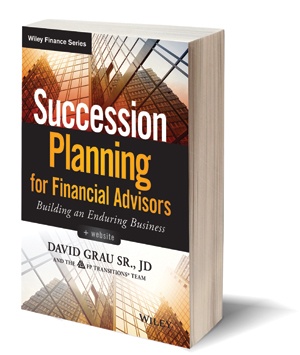I fly a lot in my work for FP Transitions—millions of miles, so far. I once asked a pilot, “If the engines of this airliner quit at altitude—say, 30,000 feet—how far can we fly before we hit the earth?” The captain said that it would vary depending upon the wind and the load, of course, but around 100 to 110 miles would be a good estimate. This is the same approach that many advisors use toward the end of their careers. Once the engines start to fade, they hold on until the end, keep the ride smooth, and make it last as long as possible. In the absence of all other choices, it’s a great plan! It is a tale of survival. In this industry, however, there are usually other, better alternatives than a dead-stick landing.
Selling Externally (to a Third Party)
Practice values have been slowly but steadily increasing over the 16 years we’ve been tracking the data, fueled in part by a strong and stable seller’s market. As mentioned, the current buyer-to-seller ratio is about 50 to 1, but we’ve never seen this result in an auction or a bidding war, at least not on our watch. Instead, advisors go about the process in a very professional manner—one that the client base tends to strongly approve of, at least in hindsight. The first criterion is quality of the match. Sellers prefer to find buyers who are mirror images of themselves, at least in terms of client base, revenue streams and investment philosophy, but larger in terms of cash flow and value (i.e., businesses tend to buy practices). The second criterion is geography. Sometimes this means a buyer close by; sometimes it doesn’t. A seller who wants to keep his or her office open, the staff employed and the same brick-and-mortar operation in place will often prefer a buyer who does not have a local presence. A seller with four months left on the lease and with no intentions of signing another lease will usually prefer a strong local buyer.

The last criterion is price and terms. Understanding the dynamics of the deal-structuring techniques associated with buying and selling a financial services practice is a prerequisite to understanding equity value. The first mistake that many buyers and sellers make when approaching a transaction is to focus on determining the purchase price without fully considering the underlying deal terms and tax allocations. In the acquisition or sale of a professional services practice, value is inextricably tied to the terms of the deal—the amount of the down payment, the use of contingent financing (such as an earn-out or an adjustable note), the duration of the financing period, the tax allocation strategy and even the interest rate the seller will charge to finance the transaction.
The most common deal structure is about one-third of the purchase price paid as a nonrefundable down payment, with the balance seller-financed over anywhere from three to six years. Typically, the more recurring revenue there is, the larger the down payment and the shorter the financing terms. Seller financing usually contains some type of contingency to make sure that the assets and cash flow actually transfer and can be retained for a period of time. The most commonly used contingent financing method is a performance-based promissory note. Earn-outs are infrequently used these days due to regulatory concerns and licensing issues.
In the marketplace for independent financial services practices selling for less than $10 million, most sales transactions and acquisitions between third parties are structured as asset sales, not stock sales (fee-only practices being the exception to the rule). Conversely, most sales transactions and acquisitions between employers and employees, or between parents and a son or daughter, are stock sales. The differences between these two methods are telling. Asset sales tend to shift control completely, all at once, whereas stock sales can be used to effect a very gradual change of control, sometimes over a period as long as 10 to 20 years. The purchase of assets provides better near-term tax benefits for the buyer. The purchase of stock provides a more gradual transition of ownership and leadership.
The average age of an advisor who sells and walks away (after an appropriate transition period to help the clients get comfortable with the chosen buyer) is about 60. Buyers tend to be in the 45 to 50 years age range. In other words, sellers who choose this strategy are a long way from the attrition model; these are practice owners who aren’t just selling what is left, but instead are selling at or close to peak value and are actively participating in choosing their replacements.
Selling to a larger, stronger business also means that most of the seller’s key staff members have job opportunities ready and waiting (provided their compensation benchmarks competitively), and it is this overall deal structure that tends to support very high transition and retention rates—when done correctly.

Internal Buyout (Selling Internally to a Partner or Key Employee)
A closely related option is selling the entire practice internally to a son, a daughter, or one or more key employees. To be clear, this option refers to a one-time sale where the ownership of the practice changes hands to a new owner—one who was formally part of the same practice. The shift in ownership and control takes place all at once and the sale is consummated with a combination of cash and promissory notes. In that regard, its structure is similar to a sale to an outside party. But mechanically, it usually doesn’t unfold anything like a sale to a third party. Most of the buyers in this category have limited cash reserves and little or no actual experience as owners (don’t confuse producers with owners—they are two entirely different things).
Most sales of this type that we see come about as a result of the death or disability of the owner of the practice. Less frequently, after a life change, the illness of a spouse, or an employment or business opportunity that requires an immediate sale, the first buyers to come forward happen to be part of the practice. This is not always the best solution, and often is the worst solution financially, but it may seem the most expedient at the time.
In an asset sale, there are two more variations. One is the sell and walk away (or fade away) form, which is self-evident, and the second is a partial book sale. The problem with the first, to be blunt, is that the internal buyer usually doesn’t have the money or the experience to step in and take over an established practice or business that quickly. So let’s focus on the more common approach—a partial book sale. The owner literally divides his or her client list into halves or thirds and then sells a partial list to the younger internal advisor. The purchase is financed on a promissory note with one adjustment period (just in case) for about three years and, if all goes well, the next batch of clients is sold on similar terms.
The partial book approach allows the two advisors to work side by side, but as two separate businesses. The name of the owner’s business can be shared as a DBA or trade name by the two sole proprietors who each run their books as they please, work the hours they choose, and earn the pay they earn. From the clients’ perspective, it’s the same practice it has always been. The seller helps the buyer and the clients gradually adjust to the changes over time, and transition risk is minimal. The transaction is never positioned as a sale, but rather as a merger or, better yet, “the early stages of a well-designed and thoughtful succession plan designed to provide the clients and their children and grandchildren with continuing services for generations to come.” Maybe it is, and maybe it isn’t.
As these two practices are run side by side, but separately, they are contractually linked with a continuity agreement. The formal continuity agreement says that the junior advisor will step in and be obligated to purchase the rest of the founder’s practice in the event of the founder’s death or disability. The junior advisor would also have first dibs on the remaining clients and assets in the founder’s practice in the event of early retirement.

More often than not, however, our one-owner practice scenario has a wrinkle in it: The junior advisor has been compensated with a revenue-sharing arrangement and has built his or her own small book under the owner’s roof. This isn’t bad or good for internal selling purposes, but it is something most independent advisors have to deal with. In some cases, we end up performing two separate valuations and literally treat the two books as two separate practices, even though the clients see it as just one business. In this case, what is being sold is the value of the founder’s book unless the junior advisor feels otherwise.
An asset sale is one way to get the job done, and that is the common pattern in a sale to a third party. Internal buyers rarely have the means to compete with better-capitalized outside buyers, and that limits the practicality of this approach as an exit strategy. That said, internal buyers have a different edge: familiarity with the clients and the owner. They don’t have to compete, but they do need some special financing to get the deal done, and that is where succession planning often re-enters the picture in the form of an incremental sale over time.
For clarity, let’s keep these options simple and separate. If you are looking to sell and walk away and your first choice for a buyer is a trusted employee or son or daughter, then the internal buyout plan works. If instead the transaction needs time to develop—for them to grow into the role of an owner, to gather the funds, and to assure you of their ability to run the business in the long run and generate the money needed to pay off the debts that a buyout would incur—then we are speaking about a succession plan, not an internal buyout.
The benefits of an internal succession plan versus an internal buyout are these: (1) As a founder, you have the opportunity to hire, train and work with your chosen successor for many years before retirement; (2) the junior partner is well-known to the client base and the practice’s referral sources; and (3) the retiring owner can retire on the job, remain in control of his or her own practice, and ensure that the client base is well taken care of for the duration. The internal successor’s lack of money can actually become a positive in this plan. A well-financed external buyer expects immediate control of the operations; the junior advisor is often glad to have a built-in, part-time mentor for many years who relinquishes control as the successor is ready to take over the reins. That this comes with long-term, low-interest, friendly financing (i.e., the seller!) is even better.
David Grau Sr., JD, is the president and founder of FP Transitions (www.fptransitions.com). This article is an excerpt from his book Succession Planning for Financial Advisors: Building an Enduring Business (Wiley & Sons).


